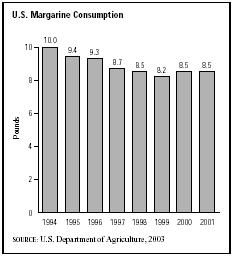SIC 2079
SHORTENING, TABLE OILS, MARGARINE, AND OTHER EDIBLE FATS AND OILS, NOT
ELSEWHERE CLASSIFIED
This category covers establishments primarily involved in manufacturing shortening, table oils, margarine, and other edible fats and oils that are not elsewhere classified. Companies primarily engaged in producing corn oil are discussed in SIC 2046: Wet Corn Milling.
NAICS Code(s)
311225 (Fats and Oils Refining and Blending)
311222 (Soybean Processing)
311223 (Other Oilseed Processing)
Many of the goods classified in this industry are long-time staples of the American kitchen. Commonly utilized for cooking and baking purposes, products such as shortening, vegetable oil, and margarine have become established presences in the marketplace. The market in the late 1990s and early 2000s was dominated by shortenings and cooking oils.
Margarine is a key product in this industry. Invented in France in 1869, margarine's introduction to the United States was initially impeded by low quality and the

efforts of a powerful butter lobby, which led to discriminatory taxes. With technical improvements and altered legislation, margarine enjoyed increased acceptance. It came to be largely regarded as a healthier and cheaper alternative to butter. By the mid-1990s, however, the $1.5 billion margarine industry began to falter while butter increased its market share. Many consumers who switched from butter to margarine for health reasons became disillusioned after learning that vegetable shortenings might also raise the risk of cardiovascular disease. Of particular concern to many health practitioners was the presence of trans fatty acids (TFAs) in margarine. In 2003, the U.S. Food and Drug Administration announced its intent to mandate the labeling of all products containing TFAs as of January 2006.
Due to the negative publicity related to TFAs, the production of margarine had started slowly declining in the late 1990s. Per capita margarine consumption declined from 10 pounds in the mid-1990s to 8.5 pounds in the early 2000s. Margarine sales declined from 1.3 billion pounds in 1998 to 1.1 billion pounds in 2003, while butter sales increased from 398.1 million pounds to 452.1 million pounds over the same time period. However, margarine sales continued to outstrip butter sales as of 2003 due to margarine's considerably lower price. Between 1998 and 2003, butter prices ranged from $2.51 to $3.17 per pound. Although margarine prices increased from 96 cents per pound to $1.08 per pound during this five-year span, margarine remained roughly two-thirds cheaper than butter.
The fastest growing segment of the industry in the early 2000s was the specialty oils market, which included blended oils such as canola/corn oil, corn/palm oil, olive/canola oil, and peanut/sesame oil, as well as flavored cooking oils that infused herbs and other seasonings, including garlic. Newer contenders like canola and olive oil had grabbed the attention of increasingly health-conscious consumers by the late 1990s. Physicians were impressed by reports that stated that the rate of heart disease in certain regions of the Mediterranean—where olive is the principal oil consumed—was relatively low, and that dietary monounsaturated fat was capable of lowering total cholesterol.
U.S. imports of olive oil during 2000 totaled 203,833 tons, a substantial increase from 1998 imports of 164,972 tons. Spain and Italy are the leaders in world olive oil production.
Further Reading
Global Information Inc. "Butter and Margarine–U.S." November 2003. Available from www.the-infoshop.com/study/mt17178_butter_margarine.html .
U.S. Department of Agriculture, National Agricultural Statistics Service. "Statistics of Oilseeds, Fats, and Oils." Washington, DC: 2003. Available from www.usda.gov/nass/pubs/agr03/03_ch3.pdf .
Comment about this article, ask questions, or add new information about this topic: